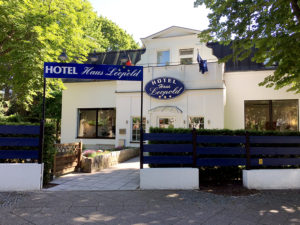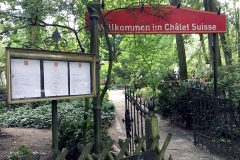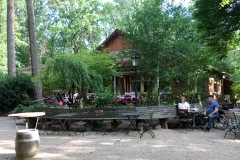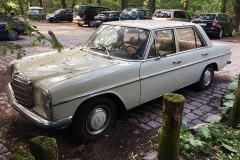We were met at Tegel Airport at about 10:30 am June 13 by Isabel Traenckner-Probst and her daughter, Eva. As we emerged from customs, we saw two tall women waving balloons and heard them yell our names.
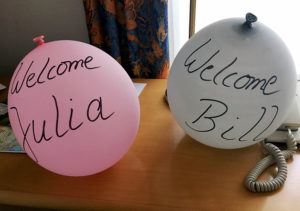 Isabel drove us to the hotel she had so kindly arranged for us, but our rooms were not ready and would not be for several hours. Recognizing we had taken a redeye, Isabel, again kindly, made her home available to us for naps. Isabel and her family, also including husband, Reiner, and son, Lars, live in one of what the locals call “American homes,” apartments originally built to house American service members and their families.
Isabel drove us to the hotel she had so kindly arranged for us, but our rooms were not ready and would not be for several hours. Recognizing we had taken a redeye, Isabel, again kindly, made her home available to us for naps. Isabel and her family, also including husband, Reiner, and son, Lars, live in one of what the locals call “American homes,” apartments originally built to house American service members and their families.
(Isabel is a great-great-grandniece of Wilhelm Canaris, German admiral and head of the Abwehr, Germany’s military intelligence agency, and she was our principal contact with the extended family. [More about the Admiral later.] My parents had lived in the Canaris house 1945-46, returned to the U.S. with two of his personal photo albums, and we were in Berlin to mark the return of those albums and other material to the Canaris family.)
After we grabbed a few hours sleep, Isabel drove us to the Hotel Haus Leopold, a favorite of her and her family, located in an upscale neighborhood of Berlin, Zehlendorf.
We came to realize that Zehlendorf was the area where my parents were married in November 1945, and where they lived after that. Most American forces lived and worked in this section of Berlin during the occupation and for many years thereafter.
That evening, we met other members of the Canaris family at a reception held at Chalet Suisse, located in a forest setting, Grunevald, in Zehlendorf. Below are scenes from Chalet Suisse.
I was surprised to learn that there were several members of the family meeting each other for the first time. Then again, as I learned more, it was not so surprising. The Canarises, while well-established in the first half of the 20th century and before, had been very much disrupted by the war and different elements of the family dispersed near its end and afterward to other parts of Europe and beyond. Many had traveled far for this night and they had a lot of catching up to do.
Isabel was also trying to develop a family tree and had brought her intial draft, sketched out on attached sheets of paper perhaps 5 ft X 12 ft in size. Family members added to the names listed there. At one point, Isabel apologized to Julia and me for everyone speaking in German. I said, “No need to speak English.” And a young woman, who was writing on the family tree, looked over at me and, with a smile, said “But we all could.”
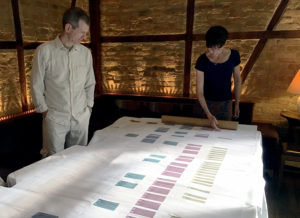
At dinner, I sat alongside my first personal contact with the Canaris family, Patricia Highfill, another great-great-grandniece. (Her picture appeared in the Christmas letter post, as I had delivered the albums and other material to her in the fall at her home in Palm Desert, Calif. She then brought them to her family’s home in Switzerland and they were conveyed to Berlin.) She urged me to try a meal with one of her favorites, rösti. I would describe rösti as high-end “hash browns.” When Julia told Eva our version of “rösti” was a popular breakfast side in the U.S., she was surprised.
I also met at dinner Michael Günther, a TV documentary producer, who is heading up production of a documentary on Admiral Canaris. Julia and I would become friends with Michael and his wife, Cornelia (Connie). More on them later, too.
Back to the hotel around 11, we rested for a big day ahead.

